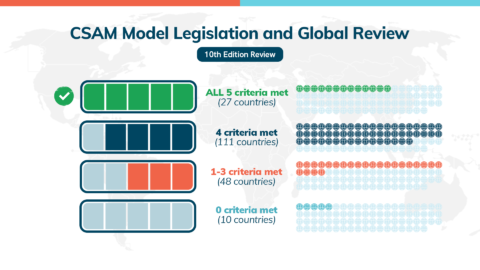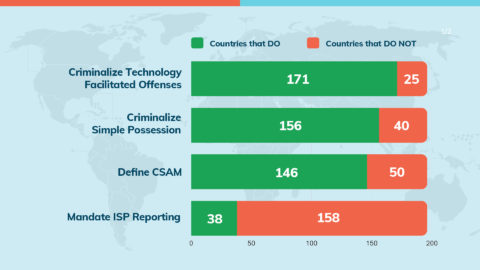We conduct extensive research into laws that exist around the world to better understand how countries deal with a problem of enormous magnitude causing harm to children.
Since 2006, we have tallied the presence – and absence – of adequate anti-child sexual abuse material (CSAM) law in 196 countries. We have analyzed the strengths and shortcomings of the laws that do exist, and, based on the results of that intensive effort, we have developed model legislation that can be adopted and adapted as needed to be effective in any society or culture.
Our groundbreaking report, Child Sexual Abuse Material: Model Legislation & Global Review, first released in April 2006, is now in its 10th Edition.
Our study of national legislation looks to see which countries:
- Generally criminalize child sexual abuse material (CSAM);
- Define what “CSAM” is;
- Criminalize technology‐facilitated CSAM offenses;
- Ban the knowing possession of CSAM, regardless of the intent to distribute; and
- Require Internet Service Providers (ISPs) to report suspected CSAM to law enforcement or to some other agency.
In addition to a legislative review, the report offers a “menu of concepts” that countries can consider when drafting anti-CSAM legislation. Key topics covered include:
- Definitions;
- Offenses;
- Mandatory Reporting;
- Industry Responsibility;
- Sanctions and Sentencing; and
- Law Enforcement Investigations and Data Retention.
The report also looks at several issues related to and influencing the spread of CSAM including the COVID-19 pandemic, computer-generated CSAM, livestreamed child sexual abuse, and sextortion. And the report provides a look at relevant regional and international legal instruments and discusses the need to not only enact legislation to protect children but also implement and enforce the laws.
10th Edition at a glance…

Seventeen years ago, our first report revealed a dismaying prospect: Only 27 countries had enacted legislation sufficient to combat CSAM offenses. Since then, the situation has improved. The 9th Edition of our report, published in December 2018, found that 118 countries had in place legislation deemed sufficient to address CSAM. Today, based on the results the 10th Edition, 138 countries now have legislation considered to be sufficient (meaning the legislation meets at least 4 of the 5 criteria).
The 9th Edition results showed that more work remained to be done. At that time, 16 countries still did not have legislation dealing specifically with CSAM. Of the 62 countries that did have some legislation in place, 51 of them did not define CSAM specifically; 25 did not deal with technology-based offenses; and 38 did not criminalize simple possession without regard to intent to distribute.

The 10th Edition of our report shows continued improvement as countries recognize the importance of the issue and take action to safeguard children around the world. Our findings show that only 10 countries still do not have legislation dealing specifically with CSAM. Of the 48 countries that do have some legislation in place, 34 of them do not define CSAM specifically; 15 do not deal with technology-based offenses; and 28 do not criminalize simple possession without regard to intent to distribute.
Want to learn more? Find a quick reference sheet on 10th Edition here. The 10th Edition Child Sexual Abuse Material: Model Legislation & Global Review is available in English. The 9th Edition is available in English and Spanish; the 8th Edition is available in English and Spanish. (Older editions are on file with ICMEC.)
*While the term “child pornography” is often still utilized in national legislation, in line with recent global movement and international consensus, the term has been replaced in the 9th Edition with the term “child sexual abuse material” as it more aptly describes the true nature and extent of sexually exploitive images of child victims to which children can never consent.

